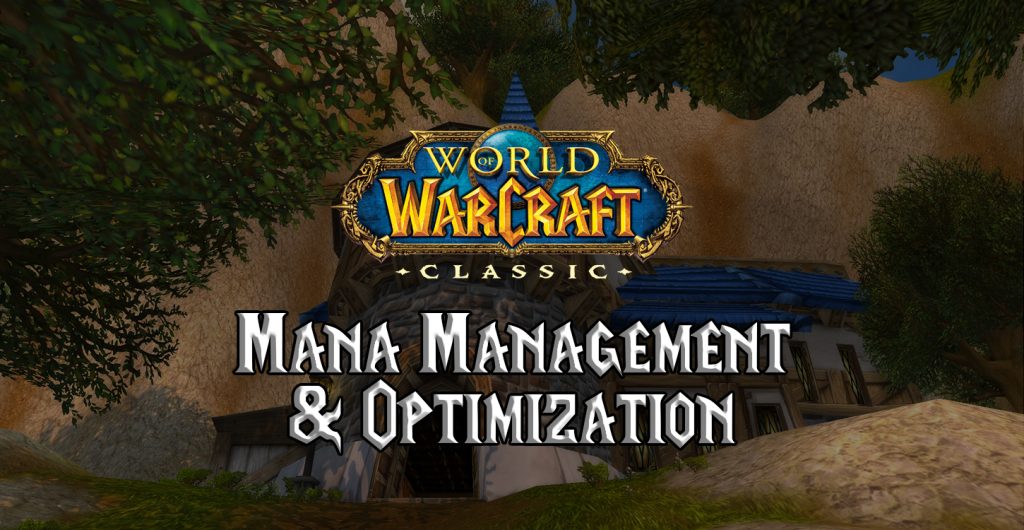- Author: Melderon
- Date: November 14, 2019
- Updated: March 23, 2025
- Expansion: WoW Classic
Greetings ladies and gentlemen, Melderon here. In this guide we will go over what stats affect your effective mana, that is, the mana you have access to during the duration of an encounter, as well as how these stats interact with each class. Finally, we will explore strategies to increase your uptime depending on your class and role.
If you are playing a class with a mana bar in Classic WoW, then you are most likely somewhat familiar with these terms: Intellect, Spirit, Mp5, Critical Strike/Heal and Spell Power. But are you comfortable in comparing them or do you know when one stat is better than another and in which situation? If you are/do not, please do not feel discouraged. These concepts are a bit more complicated than you may realize. Knowing how each of these stats work will improve your effectiveness as a healer or ranged magical damage dealer.
However, things do not stop there, melee hybrid classes like Feral Druids, Protection and Retribution Paladins, and Enhancement Shaman will also benefit from this guide, as will Hunters. I think the best thing to do first is to define each stat and discuss what they actually do, both universally and on a class-by-class basis.
Intellect
Intellect is one of the five basic stats in the game. Therefore, it will be easy to come across when gearing during the leveling process and at endgame. It increases your mana pool by 15 with each point accrued. This perhaps make it an easy stat to discuss and talk about but it also has another benefit. Each class with mana (except Hunters) also gains Spell Critical Strike chance (healing and damage) at a certain rate. The following table shows how much Intellect needs to be accrued to gain 1% Spell Critical Chance for each class at level 60:
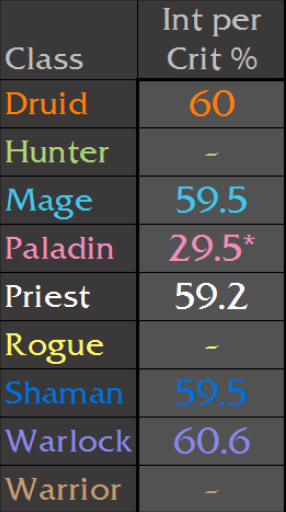
Interestingly, we can think of a Critical Strike as effective mana since a Crit produces additional damage or healing. In this way, you are getting more “bang for the buck,” if you will. This is more impactful for healers when it comes to mana management as a Critical heal can reduce your need to spend more mana directly, since your heal was more effective, or indirectly through buffs like Ancestral Fortitude (Shaman), Inspiration (Priests), and Illumination (Paladins).
The first two buffs increase your friendly target’s armor, potentially reducing your need to heal for a period while Illumination refunds mana! We will discuss Critical Strikes/Heals more in-depth in the next section.
When I talk about Intellect I will usually use the words “front-loaded” considering that the amount of mana that Intellect provides is static over the course of combat. This means that no amount of Intellect can restore your mana pool over the course of combat – it just makes your mana pool larger. In other words, if you have 100 total Intellect then your mana pool will be 1500 unless you have buffs and/or enchants that increase it further.
Before we move on, last but not least, Intellect also increases the rate at which you accrue weapon skill points. So, Warriors and Rogues, get some Intellect buffs!
Critical Strike/Heal Chance
Critical Strike/Heal Chance can be acquired via Intellect (see table above), talents, gear bonuses, or from Critical Strike increases from gear enchantments. If obtained from gear, usually, the text will read: “improves your chance to get a critical strike with spells by x%.” Because it is not one of the five basic stats, it is rare to come across while leveling but is a common bonus on high level gear.
Spell-based Crits, whether they be damaging spells or heals, provide an additional 50% bonus to the average effect, when they occur, unless talents increase that amount. So, for example, if you normally heal with a spell for 100, on average, a critical will heal for 150. Some classes can increase their Critical Strike/Heal bonus via talents. Here is a list of these classes and talents:
- Shaman: Elemental Fury (Elemental) – Increases Critical Strike damage bonus of nature spells and offensive totems to 100% from 50%
- Warlocks: Ruin (Destruction) – Increases Critical Strike damage bonus of all Destruction spells to 100% from 50%
- Mages: Ice Shards (Frost) – Increases Critical Strike damage bonus of frost spells by 20% each rank up to a total of 100% with 5/5
- Druids: Vengeance (Balance) – Increases the Critical Strike damage bonus of Starfire, Moonfire, and Wrath by 20% each rank up to a total of 100% with 5/5
In these examples, a spell that normally heals/damages for 100 will now heal/damage for 200, on average. In addition, almost every class has talents that increase their Critical Strike chance. These are usually sought after universally, regardless of the class/role.
Critical Strike/Heal as Effective Mana
As stated in the Intellect section, Crits can add to your effective mana both directly, through not having to put out as much healing or damage, or indirectly through class-related talents like Inspiration, Ancestral Fortitude, and Illumination. For damage dealing casters, Critical Strikes are not as impactful for saving mana because they still want to do as much damage as possible in an encounter. However, for healers, healing Crits can drastically reduce the amount of healing output needed. This is especially true for Paladins who, with the 5/5 ranks in Illumination, get 100% of their mana refunded! This is perhaps one of the most powerful talents in the game and make Paladins the most mana efficient of the healers once enough Crit is accrued. Combining Divine Favor with Illumination also guarantees a Critical Heal, which, in turn, guarantees a free cast. It is wise to use Divine Favor with a very expensive cast to get the most out of it! It is important to note that Fire Mages with the Master of Elements talent acts like an “Illumination light” in that Crits can refund up to 30% of their cost.
A downside to Critical Strike is that you can easily overheal an ally or overkill a target. This is much less of an issue for damage dealing casters as an overkill can only occur when a MOB or boss is about to die. Crits before this point are always beneficial, unless you pull threat. However, for a healer, a Critical Heal can be essentially wasted in part or in full if that bonus becomes an overheal. Therefore, unless you have a talent that has an added bonus like Inspiration, Illumination, and Ancestral Fortitude, Critical Heals can, and often are, wasted. We will talk about the class-specific benefits of Crit towards the end of the guide.
Spirit
Spirit is a very interesting and, usually, undervalued stat. Like Intellect, it is one of the five basic stats and will be a very common stat on gear throughout the game. Spirit’s contributions are two-fold as it increases the rate at which you regenerate health outside of combat and the rate that you regenerate mana both inside AND outside of combat. However, this mana regeneration (whether you are in combat or not) does not occur all the time. In fact, the mana regenerated from Spirit only starts to occur after you have NOT been casting for a total of five seconds. This is known colloquially as the 5-second rule.
After 5 seconds have elapsed, you will receive an increase in mana dependent on your total spirit and your class (see table below). After that, as long as you do not cast a single spell, additional mana will begin to be restored in 2 second intervals. The second you complete a cast, this regeneration will cease until you do not cast again for 5 seconds. An interesting note is that if you have a clearcasting buff/proc (i.e. Shaman with Elemental Focus and Mages with Arcane Concentration) you will not interrupt your mana regeneration with the ensuing free cast.
The amount of mana you will restore in these 2 second intervals depends on how much Spirit you have. The more spirit, the more you will restore. However, just like with Intellect-based crit, the amount of mana and/or health that a class will restore per point of Spirit is not universal. The below table illustrates how each class benefits from Spirit for both health and mana regeneration at level 60:
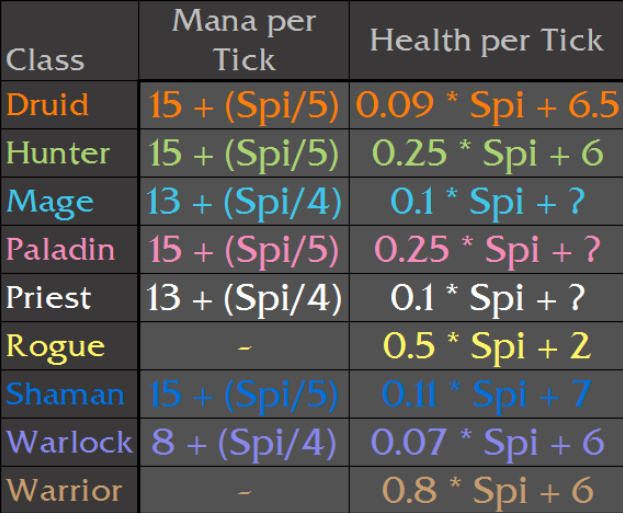
The question marks mean that the added constant is not currently known. However, when it comes to comparing between classes, the coefficients are more important
As you can see, Warriors and Rogues restore far more health, out of combat, per tick compared to other classes with their rather large coefficients (0.8 and 0.5 respectively). This is primarily due to the fact that they have no way of healing themselves and that they cannot mitigate negative debuffs without using consumables. Also, perhaps a related concept, since these classes do not have pets to soak damage and deleterious effects, they receive more bonus to their out of combat health regeneration. Because of this, it is common for Warriors and Rogues to seek out Spirit, or at the very least, save alternative pieces of gear in their inventories with Spirit. This is very beneficial during the leveling process as it can drastically reduce downtime.
Conversely, it is perhaps not surprising that Warlocks have the lowest spirit coefficient due to them having abilities like Life Tap and Drain Life, allowing them cycle between health and mana rather quickly. There are also four classes that receive additional benefits from Spirit outside of health and mana regen from talents and gear bonuses: Priests, Druids, Warlocks, and Mages. Therefore, it may be prudent to stack more Spirit in these classes.
Priest Talent & Tier Spirit Benefits
There are a total of three talents that Priests can get to increase the effectiveness and importance of Spirit:
- Meditation (Discipline) – 5%, each rank (up to 15%, 3/3), of spirit-based mana regeneration occurs while casting (inside the 5-second rule).
- Spiritual Guidance (Holy) – Increases Spell Power and Healing by 5%, each rank (up to 25%, 5/5), of your total Spirit
- Spirit Tap (Shadow) – 20% change each rank (100% chance, 5/5) for your spirit based mana regeneration to double (+ 100%) after a killing blow is dealt that yields experience or honor (or would yield experience if level capped) as long as you are not casting. If you are casting, the rate is increased by 50%
In addition to these benefits, Priests can also get more of the Spirit stat by adding on an additional 15% of Spirit-based mana regeneration while casting from the 3-piece bonus of their Tier 2, the Vestments of Transcendence. This effect stacks with Meditation.
Druid Talent & Tier Spirit Benefits
Druids only have one talent that benefit from Spirit:
- Reflection (Restoration) – 5%, each rank (up to 15%, 3/3), of spirit-based mana regeneration occurs while casting (inside the 5-second rule). Same as Priests
- Druids, like Priests, can also get an extra 15% of Spirit-based mana regeneration while casting from the 3-piece bonus of their Tier 2, the Stormrage Raiment. This does stack with Reflection!
Mage Ability & Talent Spirit Benefits
- Mage Armor – Ability/buff that allows 30% of Spirit-based mana regeneration to continue while casting (inside the 5-second rule).
- Arcane Meditation (Arcane) – 5%, each rank (up to 15%, 3/3), of Spirit-based mana regeneration occurs while casting (inside the 5-second rule). It is important to note that Mage Armor and Arcane Meditation stack. This is a very good combo to have while raiding!
Warlock Talent Spirit Benefits
- Improved Drain Soul (Affliction) – 50% chance each rank (100% chance, 2/2) for your spirit based mana regeneration to double (+ 100%) after killing an enemy with Drain Soul as long as you are not casting. If you are casting, the rate is increased by 50%
Spirit as Back-Loaded Mana
Because of these additional Spirit-related benefits, it is perhaps no surprise that these classes, especially Priests, will want to get as much Spirit as possible as it partially translates to spell power for Priests and in combat mana regen for all of the aforementioned classes. We will get into prioritizing these stats later in the guide.
In contrast to Intellect, Spirit is conditionally back-loaded mana meaning that it only increases effective mana as time elapses. The more time that elapses out of the 5-second rule, the more effective mana you gain. This is why I call it conditional – you have to be out of the 5-second rule to see the benefits. However, as previously stated, Priests, Druids, and Mages with the corresponding talents do benefit from some (5% – 15% for Priests and Druids and 5% – 45% in Mages) of their Spirit inside the 5-second rule. This means Spirit is more beneficial to these classes. However, it’s important to realize that it is not useless for other classes and roles as you will likely be outside of the 5-second rule more times than you think during an encounter, especially if you are a healer. I encourage you to record some of your raid encounters and see how often you actually are outside of the 5-second rule.
Mp5 (Mana per 5 seconds)
I like to think of Mp5 as Spirit’s sibling as its effect is very similar. However, unlike Spirit, it isn’t one of the 5 basic stats and will be very hard to come across during the leveling process. It is much more common as a gear bonus endgame and is mostly found on healing gear, but not exclusively. Mp5 does exactly what you think it does, it restores the amount of mana advertised every 5 seconds. All you have to do is add up how much Mp5 you currently have equipped and that amount will be refunded to you every 5 seconds. However, there are two important caveats.
The first is that the mana restored doesn’t come in five second intervals. That’s right, it’s called Mp5 but it doesn’t actually restore mana every 5 seconds. Like Spirit, it restores mana in 2 second intervals. I am not sure why this is the case but I think it is likely a scaling issue. It would be weird to say, restores 0.6 mana every 2 seconds. I think the developers just rounded up to a number that makes more sense so the stat feels more impactful. Additionally, 5 seconds is a pretty long time when in combat. Getting some mana every 2 seconds is a more regular, and perhaps optimal, rate. Rest assured, you still get all the mana you are supposed to, you just get a fraction of your total Mp5 across shorter intervals.
The second, and most important, caveat is that Mp5 occurs all the time. Yes, Mp5 restores mana whether you are in combat, out of combat, inside the 5-second rule, outside the 5-second rule, casting, or not casting. As long as you have mana to restore, Mp5 will keep chugging away, giving you mana back. This property of Mp5 makes it a highly sought after stat by healers and damage dealing casters alike. However, as stated previously, it is usually found on gear that grants healing spell power and not damage.
Because of the benefits of Mp5, it is classically a high-priority stat for Paladin and Shaman healers due the fact that these healers do not benefit from Spirit in any additional capacity. However, it would not be wise to totally ignore this stat if you are a Priest or Druid. We will get into this more in-depth a bit later in the guide.
Tier Bonuses that Grant Mp5
Here is a list of classes that receive Mp5 as a tier set bonus:
- Shaman:
- Augur’s Regalia (ZG), 2-piece set bonus: restores 4 mana per 5 secs.
- The Earthshatterer (Tier 3), 8-piece set bonus: while Lightning Shield is active, you restore, 15 mana per 5 secs.
- Druid: Haruspex’s Garb (ZG), 2-piece set bonus: restores 4 mana per 5 secs.
- Paladin: Freethinker’s Armor (ZG), 2-piece set bonus: restores 4 mana per 5 secs.
Mp5 as Back-Loaded Mana
Like Spirit, Mp5 is back-loaded mana. However, unlike Spirit, Mp5 is NOT conditionally back-loaded. You don’t have to wait 5 seconds for the mana regen to occur. It happens all of the time. That being said, Mp5, like Spirit, becomes more effective the longer you are in combat. Additionally, since it is not conditional, Mp5’s usefulness scales better with elapsed time. With Spirit, you don’t have any control over when you will be regenerating mana as you don’t know how often you will need to heal in most encounters. So, fight length is not something you can accurately model when considering Spirit. However, with Mp5, fight length is the main factor you will care about when budgeting this stat. For damage dealers, Mp5 will almost universally be better than Spirit since you are constantly casting. An exception is mages due to both Mage Armor and Arcane Meditation. We will get into this in more depth after we talk about Spell Power.
Spell Power
Spell Power is a highly sought after stat by healers and damage dealing casters alike as it flat out increases the damage and/or healing that your spells can produce. It is not one of the basic stats but it gets increasingly more common as a bonus stat on gear as you gain levels. By end game, almost all best-in-slots items sport some bonus Spell Power. It is important to realize that there are three different kinds of Spell Power bonuses found on gear:
- School specific: This bonus spell damage is only applied to spells belonging to a specific school. An example would be a piece of “of Nature’s Wrath” gear. If you are a Mage and use this item, none of your spells will receive bonus damage. However, if worn by a Shaman, all lightning spells will receive the bonus Spell Power. Make sure to know which schools your spells belong to.
- Damage and healing: These bonuses apply to both damaging spells, regardless of school, AND healing spells. The text in the tooltip will usually read: “Increases damage and healing done by magical spells and effects by up to x.” This gear is primarily sought after by damage dealers but some Best-in-Slot items for healers are also this type.
- Healing only: The bonuses on these pieces only increase the effect of healing spells, not damaging spells. The text in the tooltip will usually read: “Increases healing done by spells and effects by up to x.” Obviously, these pieces will only benefit healers and to make these more sought after by healers, healing-only pieces provide more bonus Spell Power than damage and healing pieces of the same or similar item level. So, try not to roll on damage gear if you are healer unless there is no other option.
Spell Coefficients & Downranking
I will make this brief because I go over the idiosyncrasies of spell coefficients and downranking in this guide (video link below). Additionally, under the guidance of Ozgar, I helped produce an interactive tool (https://wowdownrank.ozgar.se/) that lets you see how spell coefficients affect mana efficiency as available Spell Power increases.
In the vast majority of cases, not all of the bonus Spell Power you have goes to your spells. If you have ever read a tooltip with bonus Spell Power, you probably noticed the “up to” language. This does not mean there is some hidden RNG that determines how much of your bonus Spell Power gets applied to a spell. What it does mean is that each spell in the game receives a proportion of your total bonus Spell Power that is mostly determined by the spell’s cast time. For example, the Shaman spell, Lightning Bolt, Rank 10, has a cast time of 3 seconds. The reference cast time in WoW: Classic is 3.5 seconds. Therefore, Lightning Bolt, Rank 10 receives 86% of your bonus Spell Power. This is because 3 is approximately 86% of 3.5. Things get much more complicated with over-time spells, AOE spells, and even some normal, hard cast spells. I will not go over this here. Please watch the video above if you want to learn more.
One very, very important thing to realize is that bonus Spell Power increases the mana efficiency of lower ranked spells at a much higher rate compared to higher ranked spells. This is due to the fact that bonus Spell Power results in a larger percent increase in overall effect the lower the spell’s rank. This is easy to visualize. Healing Wave, Rank 4 only heals for 279 to 328 while Healing Wave, Rank 10 heals for 1620 to 1850. If you gain 500 Spell Power (attainable as early as MC for healers), that results in a percent increase to Healing Wave, Rank 4 of 141%, after the spell coefficient reduction. For Healing Wave, Rank 10, it’s only a 25% increase. This is why downranking your heals is so important as the mana cost of spells always remains constant, unless talents further reduce them. Downranking allows you to cast more in a given amount of time. For healers, you rarely need to use max rank heals unless there is an emergency. Therefore, Spell Power can increase your mana efficiency greatly.
I’m sure you are wondering about damage dealers. If your primary goal in a raid or dungeon is to do damage, then you will likely not downrank unless you are going to run out of mana and have no consumables and/or cooldowns at your disposal. Despite increases in Spell Power making lower ranks more mana efficient, higher ranks will always just produce more raw output. This is why, for damage dealers, downranking is not commonly done. However, for hybrid casters like Balance Druids and Elemental Shaman, who lack abilities like Life Tap and Evocation, downranking may be more common.
Spell Power as Effective Mana
Spell Power, like Critical Strike/Heal, can be thought of as adding to your total effective mana pool. This is because, the more Spell Power you have, the less you will have to cast. This works synergistically with downranking as you can now effectively use lower ranks of spells more often, saving a lot of mana. For damage dealers, as stated above, spell power as mana is not really pertinent. You will still be casting as hard as you can to produce the most damage possible in a given encounter.
However, you may not notice this at first, but after weeks of clearing the same raid, the kill times of trash and bosses will decrease. This is because the more geared your raid becomes, the more spell power your caster core will accrue, and the quicker you will kill bosses. Therefore, it may take a while to realize this as a caster but the more Spell Power you, and your allies have, the more mana you will save in the long run. This will allow you to save money on consumables or save your cooldowns for when you need them most.
For healers, the benefits of Spell Power are much more apparent to the individual. The more Spell Power you have, the less frequent you will have to heal and the more lower ranked spells you can use in your arsenal. Because of this, as your raid progresses, you will notice that you will spend less mana than when you did when you first entered the raid.
This may seem a bit strange at first but it occurs for two reasons: 1.) You don’t need to heal as much as you once did because your raid is more geared and 2.) More Spell Power leads to more downranking, saving you mana. Also, as with damage dealers, the more geared the healing core gets as a whole, the more powerful this effect will become. For instance, in my raid, we converted two healers to DPS recently because we just don’t need as many healers now, on farm status, as we did during progression.
It is important to realize how your Spell Power can increase your effective mana pool during encounters. Don’t just mindlessly heal because you feel like you have to. If you don’t need to throw out a heal, regen some mana from your Mp5 and Spirit!
Consumables, Talents, Buffs, & Enchants
As we discussed with Spirit, talents can increase any of the stats we have already talked about as well as add new effects like in Spiritual Guidance in Priests. Just be mindful of what talents increase your stats’ effectiveness.
As far as consumables go, there are primarily two types of consumables that casters and healers will want to have on them during raids or even in dungeons settings that add to your effective mana pool: Mana Potions and Dark/Demonic Runes. Potions and Runes have DIFFERENT two-minute cooldowns and can be used one after another to restore mana. Always try to have one or both of these items on you at all times.
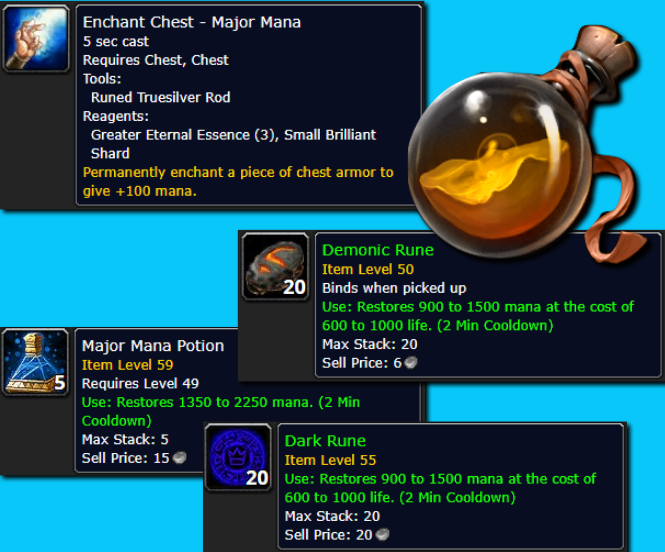
Finally, we can talk about buffs. Buffs usually act by increasing a stat we have already talked about and, therefore, technically can be considered flat additions to those stats. They can come in the form of elixirs, flasks, food buffs, world buffs, class buffs (i.e. Prayer of Spirit and Blessing of Wisdom), etc. However, some buffs and enchants statically increase your mana pool outside of stats (i.e. Enchant Chest – Major Mana). These also add to your effective mana pool. As a healer/caster, try to accrue as much effective mana as you can from all sources.
Now let’s get into how to budget stats on a class by class basis and how certain factors can significantly alter stat weights.
The Effect of Time on Stats
When we put everything together, we can imagine an equation that looks like this:

But, as we know, in reality, there are more terms that we can add to this equation:

Ok, that looks better…
Actually, let’s make it even more complicated:

where, t = a decimal representing time in minutes (total = the elapsed time of the encounter and 5sr = time spent outside the five section rule), OH = the proportion of overheals, BSMR = Bonus Spirit-based Mana Regeneration from talents/gear, DRP = DownRanking Penalties (if any), and #CDs = how many cooldowns for potions and runes are available during the course of the encounter.
This is a much more complicated equation with many factors that we need to consider. This makes creating stat weights pretty complicated, however; we can make some proper guidelines and assumptions thanks to one of the terms above: time.
Time changes everything. The longer the fight, the less Intellect matters while Spirit and Mp5 become more powerful. Conversely, in a short fight, front loaded mana from Intellect and Spell Power will carry you through while there just isn’t enough time for Spirit and Mp5 to make an impact. Let’s look at some comparisons.
Stat Comparisons
1 Intellect = 15 mana. Intellect is an easy baseline metric for us to compare things.
For 1 Mp5 to be equivalent to 1 Intellect, it would take 75 seconds of elapsed time. This is because 1 Mp5 restores 1 mana every 5 seconds. So, it would take 75 seconds for this amount of Mp5 to restore 15 mana (1 Intellect worth of mana). Therefore, we can think of Mp5’s effectiveness scaling non-linearly with time. Before 75 seconds, Mp5 is rather weak. However, after 75 seconds, it’s effect becomes much more pronounced, increasing exponentially. Intellect, on the other hand begins to decrease in effectiveness around 75 seconds in an opposite way. The plot below is an attempt to create a visual representation of concept that has a lot of moving parts. However, in general, think of Mp5 maturing and getting more potent as the length of the fight increases:
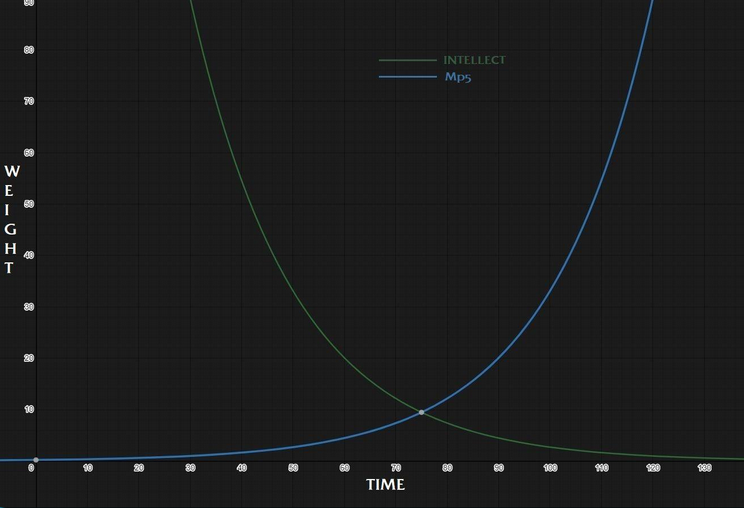
Mp5 is very easy because it universally restores mana at the same rate for each class. 1 Mp5 restores 1 mana every 5 second for every class, with mana, in the game. For Spirit, our answer is not universal as some classes benefit from Spirit slightly differently. The table below shows, for each class, how much time needs to elapse outside of the 5-second rule for 1 Spirit to equal or surpass 1 Intellect. Unfortunately, since Spirit regenerates mana every 2 seconds after you don’t cast for a total of 5 seconds, the answers are not as clean compared to Mp5. Remember that this DOES NOT take into account additional benefits from Spirit from talents and gear:
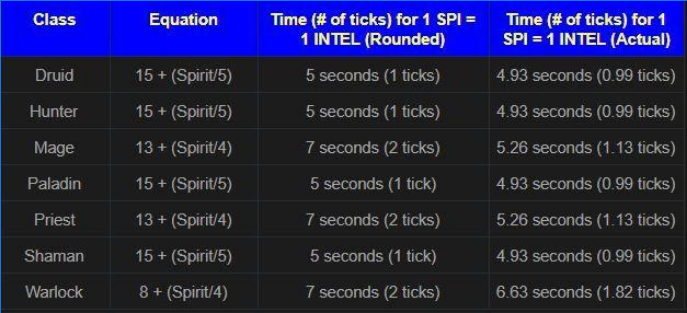
For all of the results in the “Rounded” column above, it actually takes less than the time shown for 1 Spirit to equal 1 Intellect but, since Spirit works every 2 seconds, it appears more universal than it actually is. That’s why, in the last column, I give you the actual rates. You may be thinking, why are none of these 2 seconds? Shouldn’t Druids, Hunters, Paladins, and Shaman reach equal weights of Spirit and Intellect after 2 seconds? Remember, your first tick of Spirit occurs after you do not heal for 5 seconds and then each subsequent tick happens every 2 seconds while you are not casting. So, if you want to know how long it will take for 1 point of Spirit to equal 1 point of Intellect after the first 5 seconds (first tick), just subtract 3 from the total time (in seconds) from the table above. For classes with talents that allow for some of your Spirit-based mana regeneration to occur while casting, that mana will always regeneration every 2 seconds.
You’re likely thinking now, “Wow, Spirit is so much better than Intellect and Mp5!” For Priests, you may be onto something, but remember, that in order for most classes to benefit from Spirit, you have to stop casting for 5 whole seconds. That may not seem like a lot of time, but it really is, especially for damage dealers. Outside of a mechanic that makes you move across the room, can you Mages or Warlocks think of a time you have stopped DPS for 5 seconds or more? Likely not. Therefore, Mp5 is more useful compared to Spirit under most conditions for damage dealers. However, for healers, even if we don’t consider the added benefits that Druids and Priests get from Spirit, you’d be surprised how many times you gain some Spirit-based mana regeneration during an encounter.
Sometimes, as a healer, you don’t have to heal while in other encounters, you are healing constantly. Therefore, Spirit for Paladins and Shaman is not a worthless stat. Now, don’t get me wrong, I wouldn’t go buy up a bunch of green Spirit gear in the AH, but I wouldn’t be scared of it if it is on a piece of gear that would be an upgrade or sidegrade. As a healer, I highly recommend having different pieces of gear for different encounters of different durations. This is because, as with Mp5, Spirit’s effectiveness becomes higher the longer the fight.
We have two more stats to talk about before we move onto class-specific stat budgeting: Crit and Spell Power. Crit is a very hard stat to think about as a healer, unless you are a Paladin, because its unpredictable in two ways: 1.) you don’t know if it will occur or not and, 2.) you may overheal the target. The RNG nature of Crit means that you can’t rely on it and overheals do not add to your effective mana because they will not assist you or your raid in any positive way. For these reasons, most healers just grab Crit if it is part of an upgrade or a set bonus.
In Horde raids, since there are so many Shaman and Priests, Ancestral Fortitude and Inspiration are almost guaranteed to be on the melee and tanks – the people that actually need it. This occurs primarily due to Chain Heal spams. And, in Alliance raids, Priests will provide Inspiration to tanks while Paladins can quickly heal all other targets with fast, cheap heals. Now, for casters, things are very different. Many damage dealing caster classes, like Mages and Elemental Shaman, hold Crit very high in their stat priorities. Since Crit is a flat increase to damage, most casters will take as much as they can.
Finally, we have Spell Power. This is even harder to discuss because there are so many different spell coefficients in the game as well as many spell effect ranges. So, what I will do is provide example calculations using some Shaman and Druid spells to answer the question of how much spell power is equal to 1 point of Intellect, or 15 effective mana for these spells:
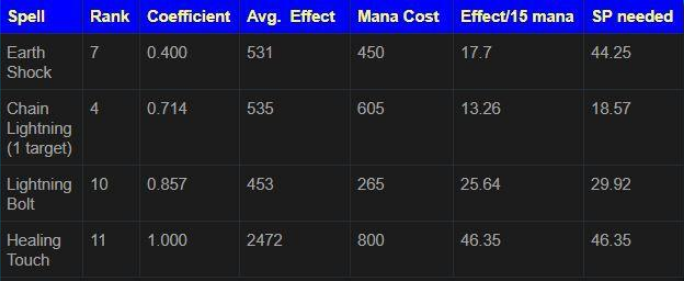
Yes, that’s right! You will have to calculate how much Spell Power is equal to 1 Intellect for each rank of each spell. Not only does the math take time, but you must know each spell’s coefficient. This is why it is hard to determine how to weigh Spell Power compared to Intellect. Thankfully, for most gear at end game, you will get both Intellect and Spell Power. This makes budgeting and balancing both of these stats quite easy. As a general rule, however; you will want to prioritize Intellect over Spell Power for long fights while doing the reverse for short ones. This is primarily true for healers and some DPSers. But for Mages and Warlocks, who have abilities to increase their effective mana pool significantly, Spell Power will always be king. Speaking of budgeting, let’s get into that for each class.
Stat Budgeting for your Mana Pool
Determining the order in which you should seek these stats is highly dependent upon your class and your talents. The suggestions below are based on theory and the personal experiences of myself and close colleagues. Therefore, different stat weights may make more sense to you. This is especially true when you consider the type of guild you are in as guild’s with higher skill will clear raids must faster, making Intellect sometimes far superior. On the other hand, if your guild is more casual, encounters may take a lot longer, making Spirit and Mp5 more impactful.
It’s important to consider your personal preferences and your environment when budgeting stats. Simply use this guide as a learning tool to make more informed decisions. I don’t go over this in this guide because this guide is all about mana management, however; if you are a DPS class, acquiring Spell Hit (cap is 16%) is very important in addition to increasing your effective mana pool.
Usually, you want to prioritize increasing hit first but this is class dependent. Seek out individual PvE guides to determine where Hit fits in the grand scheme. Healing, unlike damage, is unique in that you don’t need any Spell Hit Rating to heal a target. Heals are guaranteed to land unless your target has a debuff, they run out of range, or they are dead. Let’s now look at stat budgeting suggestions for each class.
Hunters
You guys are the easiest so we will do you first. There really isn’t that much room for choice when it comes to gear as your tier sets are really great. You’ll likely notice that your tier pieces provide you a good amount of Intellect that should make lasting an encounter generally easy considering your abilities are far less expensive compared to those of casters. If you are having issues for some reason, consider bringing some Major Mana Potions and Dark/Demonic Runes with you to a raid. If you are a Nightfall proccer, you will be spamming Wing Clip, Rank 1 over and over again. Since this ability only costs 40 mana, this should not drain your mana in any significant way as long as you have a healthy amount of tier gear and buffs.
Warlocks
You Warlocks are pretty lucky. Life Tap is an extremely useful talent as it converts health to mana, allowing Warlocks to have a theoretically limitless mana pool – as long as your healers aren’t sleeping, that is. Due to Life Tap, you can really go crazy with Spell Power and get as much as you can. However, having a healthy mana pool is also important as you want to limit Life Tapping as much as you can to give your healers a break. Therefore, I would suggest prioritizing Spell Power first and then get as much Critical Strike as you possibly can because of Ruin. This talent will make your Shadow Bolts hit like a truck! After these two stats, prioritize Intellect over Mp5 and Spirit, in that order, to build a nice mana pool.
Mages
Mages, like Warlocks have abilities that drastically increase their effective mana pools. Evocation grants almost another full mana bar while conjured gems, like Mana Ruby (which share a cooldown with Dark/Demonic Runes), can provide mana in an instant. In addition, Mage Armor allows a whopping 30% of their Spirit-based mana regeneration to occur while casting! Since this is an ability and not a talent, all Mages, regardless of build, have access to it. Mage Armor will regenerate ~4 mana per tick for every point of Spirit. Arcane Meditation will regen ~2 mana per tick per Spirit. If you have both, that’s ~6 mana per tick for every point of Spirit you have. Pretty amazing! Because of these tools, like Warlocks, you should budget Spell Power and Crit (to make use of Ice Shards if Frost or Ignite if Fire) first before looking to boost your mana pool with Intellect, Spirit, and Mp5. Because of Arcane Meditation and Mage Armor, Spirit may be a better stat to stack over Mp5. And, since all of the Mage tier pieces have a good bonus of Spirit, this should not be difficult. Just make sure to use Mage Armor whenever you can!
Druids
Whether you are Balance or Resto, you will likely have the Reflection talent to get some bonus mana regeneration while casting from your Spirit. So, for every 1 point of Spirit you have, you will gain 2.28 mana every 2 seconds while casting. That really isn’t that shabby at all as it will only take 7 ticks to regenerate 1 Intellect’s worth of mana. However, it’s not enough to drastically alter your stat priority as a Balance Druid. What stat to focus on as a Balance Druid is highly phase-dependent.
Because Balance Druids will find it hard to get Hit-capped before ZG gear, the main stat to focus on is Spell Power. Once you get over 400 Spell Power or so, move into getting Crit to really make your Vengeance talent work while also gathering Intellect to build up your mana pool. Early on, Spell Power provides more stable DPS through out fights and makes up for the lack of effective mana.
Just make sure to load up on consumables, like Major Mana Potions and Dark/Demonic Runes, so you can stay up during longer encounters. For especially long fights, you may want to consider switching in some Intellect and Spirit gear so you can last considering that Balance Druids will usually Innervate healers over themselves. Later in the game, you should have accrued enough Intellect, Spirit, and Mp5 via gear to be more comfortable in most encounters.
As far as Resto Druids are concerned, Taladril recommends going for Spell Power first, considering how efficient Healing Touch is. Remember that Healing Touch is the only 3.5 second heal in the game, meaning that it receives 100% of your bonus Spell Power. Landing such a long cast can be tricky but if you do, you can really make an impact. After this, you should stack Intellect, Spirit, and Mp5 in that order.
Priests
Healing Priests benefit a lot from Spirit. However, Shadow Priests usually only spec into Meditation. Therefore Spirit is not as important for them compared to Spell Power, Intellect, and surprisingly, Mp5. Because Shadow Priests can run out of mana very quickly and will not have a large base of Spirit, especially early on, it may be more prudent to stack some Mp5 over Intellect. This may be challenging since finding spell damage gear with Mp5 isn’t easy but I suggest getting as much as you can! Your priority should look like: Spell Power, Mp5, Intellect, Spirit, then Crit, in that order.
Now for healing priests. Regardless of your build, unless you are Power Infusion spec, you should have both Meditation and Spiritual Guidance. Because of this, Spirit is very important as you will restore 2 mana per 2 seconds while casting and receive 0.25 Spell Power for every point of Spirit you have! This is super impactful and makes Spirit a stat you will strive to get. However, you still want to get as much Healing Power as you can first. And after that, Defcamp, highly suggests building a nice mana pool – not too little but not too much either. You want to acquire enough to feel comfortable knowing you can last the fight.
Once you attain this, stack as much Spirit as you possibly can. It will be especially useful in longer fights while also making your heals have higher throughput. Spirit is really a win-win. However, Crit and Mp5 are not useless considering Crit can increase your chance to apply Inspiration and Mp5 will restore mana regardless of what you are currently doing. You should not shy away from either stat, especially Mp5, if they are found on a potential upgrade.
Shaman
Elemental Shaman are all about that Crit thanks to Elemental Fury, making their lightning Crits do double damage. Get as much as you can but also really look out for bonus Spell Power as Lightning Bolt scales very well with it with a 86% coefficient. Now things get a bit tricky. Since both Elemental Shaman and Restoration Shaman cast a lot and do not receive any bonuses from Spirit like Druids and Priests do, budgeting Mp5 and Intellect really depends upon fight length. Because of this, I try to keep two sets of gear in my bags, ones with lower Intellect and Spell Power but more Mp5 for longer fights and ones with high Spell Power and Intellect for shorter ones. Mp5 is much harder to come across in gear with spell damage but hold onto pieces that do have it.
Also, remember that Shaman have their own pocket Mp5 generators at their disposal in the forms of Mana Spring Totem and Mana Tide Totem (31-point Restoration talent). Since these totems cost mana, make sure to stick near them for as long as you can to get the full effect. You will have to spend 20 secs in the range of your Mana Spring Totem to net gain mana. Spirit is not a horrible stat but its not something you will be searching for. It some Spirit comes on gear that is an upgrade, great. If not, don’t bother. Lastly, like Balance Druids, it is imperative that you take Major Mana Potions and Dark/Demonic Runes for long encounters.
Resto Shaman have it kind of hard early on before phase 5. There are currently two schools of thought: stack Mp5 or stack Healing Power. There are two things that tend to dictate which build you should go with: 1.) whether you are tank healing and 2.) how long the fight is. I highly suggest checking out the Egregious Classic Resto Shaman Progressive BiS to really understand what I am trying to convey. However, the Tier 1 pieces provide excellent Mp5, even throughout BWL, that are excellent for longer fights and really boost your Healing Wave effectiveness. Conversely, the off-tier pieces from MC and Tier 2 provide higher levels of Healing Power for shorter fights while also boosting Chain Heal to increase your raid healing potential.
Again, which itemization you go with is really dependent on fight length and your healing role within your Shaman core. Ideally, at some point, all Shaman should gather both sets to heal well in any environment. As with Elemental Shaman, Spirit is not sought after but should not be avoided if part of an upgrade. After BWL, gear choice becomes streamlined as you will have a healthy balance of all the important stats: Spell Power, Intellect, and Mp5.
Briefly, if you are an Enhancement Shaman, you will likely be both totem twisting and proccing either Annihilator or Nightfall, while also helping out the healers. Because of this, make sure to have some pieces with Intellect and Mp5, and plenty of consumables, to keep your twisting up!
Paladins
Ok, Paladin time! Let’s briefly discuss both Retribution and Protection. Both of these specs, even though they are melee, rely heavily on mana considering all of their abilities, outside of auto attacks, require it. However, due to the importance of damage mitigation stats for tanking, Protection Paladins don’t have a lot of room for Intellect, let alone Spirit and Mp5, on their gear budgets. Retribution Paladins suffer a similar issue in that damage increasing stats are too important to pass up. Abilities like Seal of Wisdom and Blessing of Wisdom can help mana management but, in reality, the only suggestion I can give is try to get as much Intellect as you can without hindering your damage output or threat generation. Also consumables like Major Mana Potions and Dark/Demonic Runes may be extremely useful. Try to accrue as many as you can!
For Holy Paladins, things are much more clear cut. Because of Illumination, Healing Crit is vastly important. However, you want to stack Spell Power and Intellect in that order first to create a healthy base of healing throughput and total capacity. Due to the rate at which Paladins accrue Crit from Intellect (they need approximately half as much as other classes to gain 1% Crit: ~ 30 Intellect to 1 Crit), you will effectively be killing two birds with one stone. While gathering Spell Power and Intellect, get as much Crit as possible as it serves as your primary source of mana efficiency, again, due to Illumination. Mp5 and Spirit are well and good but tend to pale in comparison to Crit, even in longer fights. Because of Illumination and the Intellect to Crit ratio, Paladins are the most mana efficient healers in Classic WoW. Your priority should be Spell Power, Intellect, Crit, Mp5, and Spirit, in that order.
Well, we covered a lot of ground. I appreciate you making it this far. There are many concepts we covered and I understand if you don’t grasp all of this. However, I feel that knowing how each of these important stats affects your overall mana pool is essential to healing or DPSing as a caster in Classic WoW. Therefore, if you have any questions or comments, please feel free to let me know in the thread below or hit me up on Discord at Melderon#1287. I will try to reply as quickly as I can.
Before I say goodbye, I would just like to summarize this guide in a few sentences. I feel like the main take-away is that certain variables, like fight length, guild capability, and role, can sometimes, depending on your class, really alter which stats are important. Spending time to think about what stats are best for you or for a certain encounter can really improve your overall experience. Finally, if you are a healer, really spend time to understand how downranking works and which heals you should hotkey. Most of the time, you will have 3-4 ranks of each of your healing spells on your bar for each and every circumstance.
Thanks again so much for checking out this guide. I would like to personally thank Egregious, Defcamp, and Taladril for helping with the construction of this guide. Looking forward to seeing you on the next one. In the meantime, keep on key bindin’ and grindin!’ Peace!

